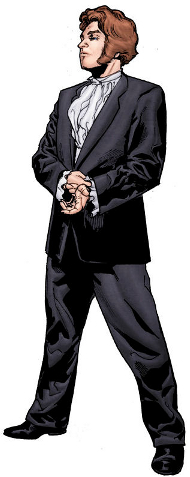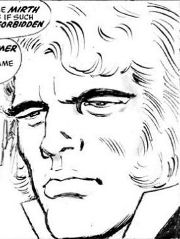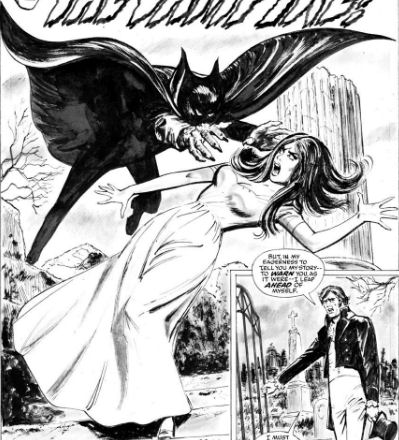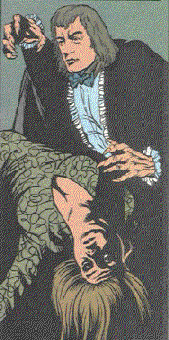 LORD RUTHVEN
LORD RUTHVEN
 LORD RUTHVEN
LORD RUTHVEN
Real Name: Ruthven (first name (presumably) unrevealed)
Identity/Class: Vampire, early
19th-Century era;
citizenship unrevealed;
true identity secret to general public
Occupation: Aristocrat
Group Membership: None
Affiliations: Earth's Vampires
Enemies: Aubrey
Known Relatives: Jessica Aubrey Ruthven (wife, presumed deceased), Aubrey (brother-in-law, presumed deceased)
Aliases: Earl Marsden, the Living Vampyre
Base of Operations: England; Greece
 First Appearance: (historical)
The Vampyre, New Monthly Magazine (April 1, 1819);
First Appearance: (historical)
The Vampyre, New Monthly Magazine (April 1, 1819);
(Marvel)
Vampire Tales#1 (August, 1973)
Powers: Lord Ruthven sustained himself by feeding on blood or young women's life force. He presumably possessed the usual powers of a vampire: superhuman strength (enhanced human), limited shape-shifting powers, control of vermin and wolves. He was presumably unable to be killed by conventional weaponry, but especially susceptible to silver or wooden stakes, and possibly to religious icons. Unlike many vampires, he was immune to sunlight.
On one account, Ruthven seemed susceptible to destruction by means that would kill an ordinary human, but with the ability to be returned to vitality by moonlight, though this may have been part of a ruse.
Loth Ruthven was a learned man with some fighting experience.
History: The means by which Lord Ruthven became a vampire remain unknown.
(Vampire Tales#1) - By the early 1800's, Ruthven had insinuated himself into high society. He met a young man named Aubrey
who, along with his sister, had inherited a considerable fortune. When Aubrey decided to tour continental Europe, Lord Ruthven joined him.

On this trip, Aubrey observed peculiarities about Ruthven -- he gave money to compulsive gamblers, thieves, and so forth, but not the "virtuous poor,"; also, whoever received money from Ruthven soon encountered misfortune -- up to the death penalty. Aubrey parted ways with Ruthven in Rome, going to Greece alone. In Athens, he roomed with a family and became enamored of Ianthe, the host's daughter. Ianthe informed Aubrey of local vampire legends, and Aubrey felt startled to discover that Lord Ruthven closely matched certain features attributed to vampires.
Later in Aubrey's trip to Greece, he traveled through the woods when a severe storm hit. Aubrey hid in a nearby hut. With no light in the hut, Aubrey heard a woman groaning, and an unseen assailant struck him. About to be strangled, only the arrival of peasants with flaming torches saved Aubrey. Aubrey then discovered Ianthe's corpse on the floor -- with teeth marks on her throat.
Aubrey returned to Athens with a raging fever. Oddly, Ruthven returned as well, to nurse him back to health. Making amends, the two continued their European tour. However, bandits attacked them in the Greek mountains. Mortally wounded (or so he claimed), Ruthven demanded of Aubrey a promise to tell no one for a year and a day of Ruthven's misdeeds or his death. Aubrey made the promise. Ruthven made another request -- that his body be placed on the mountain to catch the first ray of the rising moon, a wish that was fulfilled. Aubrey returned to the spot later, to find Ruthven's body missing, and assumed that robbers took the body to steal his clothes.
Returning to London, Aubrey met his sister's lover, Earl Marsden -- whom he recognized as Lord Ruthven. As Ruthven reminded Aubrey, due to his oath, he could say nothing and give no warning. Aubrey found himself going mad with frustration, and ruptured a blood vessel, leaving him dying. Ruthven married Aubrey's sister, who quickly became his next victim.

(Official Handbook of the Marvel Universe Update '89#2 / Doctor Strange III#15/2) - Lord Ruthven continued his existence as a vampire at least into the early part of the 20th century, continuing his occasional travels to the Greek isles. He possessed the Darkhold, obtaining it after Cagliostro. The Darkhold was later passed to Taboo. (see comments)
(Doctor Strange II#62 - BTS) - Lord Ruthven, had he still existed as a vampire when Doctor Strange cast the Montesi formula, would have fallen prey to destruction along with the other vampires on Earth-616.
(Doctor Strange III#15/2) - Lord Ruthven's past was recounted in the Book of Vishanti, as a part of the history of vampirism.
(Blade III#12 - BTS) - A prophecy was fulfilled that brought back all vampires that ever died.
Comments: Created by John Polidori, adapted by Roy Thomas, Ron Goulart, and Winslow Mortimer.
Note that The Vampyre was originally credited to Lord Byron, but was actually by Polidori
Very few stories have featured Lord Ruthven, but the Official Handbook of the Marvel Universe Update '89 #2, noted in the history of the Darkhold that Ruthven may have possessed the Darkhold at some point in the later 19th century/early 20th century. If so, he may have possessed it just after Cagliostro but before Taboo This would make sense, as Ruthven often operated in the Greek isles, and Taboo, active in nearby Turkey, could have acquired it from him under unknown circumstances. Has any published story clarified this issue?
For what it's worth I'm the one who threw Ruthven in VISHANTI; Roy added Varney. Your theory about Ruthen being the previous owner of the Darkhold after Cagliostro and before Taboo is totally correct. We never made that clear in the copy--Jean-Marc Lofficier.
My exegesis that Ruthven only pretended to be destroyed by the bandits arises from the powers and weaknesses attributed to vampires in the Earth-616 universe. Vampires have healing powers that would take care of most ordinary wounds, and moonlight has not to my knowledge been known to affect their recuperation in any way.
I should note that Lord Ruthven--and most fictional vampires in literature, including Dracula in the Stoker novel--were depicted as being active in the daytime. There was no indication that vampires would burn up or be destroyed by sunlight in these early stories.
The idea that sunlight would cause vampires to become ashes was created by the film Nosferatu (1921). (The film was remade in 1979 with Isabelle Adjani and Klaus Kinski, as well as serving as the subject of a pre-Green Goblin Willem Dafoe film Shadow of the Vampire). This film told the tale of Graf Orlock, a vampire in Germany in 1838 who gets vanquished when a woman allows him to drink her blood, keeping him occupied until the sun rises.
Although Nosferatu's producers got sued by Bram Stoker's widow (they had not acquired the rights to Stoker's Dracula novel before making the film), and consequently most copies of the film were destroyed per a court order, some knowledge of the film's plot must have leaked out. The idea of sunlight destroying vampires did not get used in the 1931 Bela Lugosi film version of Dracula, but other vampire films in the 1930's and 1940's did use the idea. Such films include Son of Dracula, Return of the Vampire (in which Bela Lugosi appeared as vampire Armand Tesla), House of Frankenstein and House of Dracula (in those last two John Carradine appeared as Dracula) did use the idea. 1958's Horror of Dracula with Christopher Lee cemented the idea, as Dracula was defeated when Van Helsing (played by Peter Cushing) threw open the curtain to reveal the rising sun.
So, when Tomb of Dracula began in the early 1970's, Gerry Conway, who wrote the first few issues, found himself well aware of the idea from the movies that sunlight caused vampires to disintegrate. Frank Drake's vampirized love interest Jean became one of the first vampires in the modern Marvel universe to suffer destruction in that way in the second issue. Later, when Marvel did an in-continuity adaptation of the Bram Stoker novel, they had to explain that the Bram Stoker of Earth-616 had collected documents written by participants in the events of the story, but that Stoker had embellished the true events as they occurred on Earth-616--including depicting Dracula active in the daytime.
Also, Prime Eternal notes that there is some mention of Lord Ruthven in The Count of Monte Cristo...
In Blade III#12 a prophecy was fulfilled that brought back all vampires that ever died. This most likely included Ruthven as well. We'll have to wait if he resurfaces.
--Markus Raymond
Clarifications: Lord Ruthven should not be confused with:
images: (without ads)
Vampire Tales#1, Lord Ruthven story: pg. 1, panel 1 (attacking a woman);
pg. 2, panel 4 (face);
Vampires: The Marvel Undead: Lord Ruthven entry - main image
by Steve Kurth
Appearances:
Vampire Tales#1 (August, 1973) - Roy Thomas & Ron Goulart (writers), Win Mortimer (artist), Roy Thomas (editor)
Dr. Strange III#15 (March, 1990) - Roy Thomas & Jean-Marc Lofficier (writers), David & Dan Day (artists), Ralph Macchio (editor)
Last updated:03/23/14
Any Additions/Corrections? please let me know.
Non-Marvel Copyright info
All other characters mentioned or pictured are ™ and © 1941-2099 Marvel
Characters, Inc. All Rights Reserved. If you like this stuff, you should check
out the real thing!
Please visit The Marvel Official Site at:
http://www.marvel.com
Special Thanks to www.g-mart.com for hosting the Appendix, Master List, etc.!